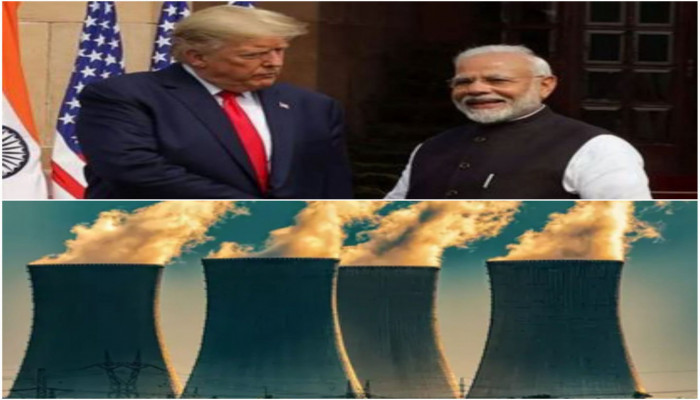Nearly 20 years after nuclear deal, DoE clears US firm to build & design reactors in India
- In Reports
- 12:47 PM, Apr 01, 2025
- Myind Staff
After nearly two decades of negotiations and regulatory hurdles, the India-US civil nuclear deal has reached a significant milestone. The US Department of Energy (DoE) has officially approved a US company's collaboration in designing and building nuclear power plants in India. The foundation for this agreement was laid back in 2007 when then-Prime Minister Manmohan Singh and then-US President George W. Bush signed the civil nuclear deal. However, the path to implementation has been long and complex, involving extensive discussions, legal and regulatory approvals, technology transfer agreements, liability considerations, and detailed planning. With the final clearance in place, the project can finally move forward.
Until now, the India-US civil nuclear deal allowed American companies to export nuclear reactors and equipment to India but barred them from participating in design work or manufacturing nuclear components. However, India remained firm in its demand that all aspects, such as design, manufacturing, and technology transfer, must take place domestically. Successive Indian governments upheld this stance. After years of negotiations and Russia making significant inroads in the sector, the US has finally agreed to India’s terms. As a result, American and Indian companies will now collaborate on manufacturing Small Modular Reactors (SMRs) and jointly produce all related components and parts. This breakthrough is widely seen as a prominent victory for Indian diplomacy. The approval for this arrangement was granted on March 26, 2025.
The US has attached a condition to its agreement to design and manufacture nuclear power plants with India jointly. Specifically, the US requires that these plants "will not be re-transferred to any other entity or end user in India or to other countries except the United States without the prior written consent of the Government of the United States."
According to the US government, India's civil nuclear energy market has enormous commercial potential. To tap into this, the US Department of Energy has given Holtec International the green light to bypass particular restrictive regulations, granting them special authorisation.
The approved regulation, 10CFR810, which falls under Part 810 of Title 10 in the Code of Federal Regulations, is a part of the US Atomic Energy Act of 1954. Specifically, it relates to the Department of Energy's "statutory responsibility for authorising the transfer of unclassified nuclear technology and assistance to foreign atomic energy activities within the United States or abroad."
The US Department of Energy has granted Holtec International permission to share its "unclassified small modular reactor (SMR) technology" with three Indian companies. These companies are Larsen & Toubro Limited, Tata Consulting Engineers Ltd, and Holtec's regional subsidiary, Holtec Asia.
Holtec International, a US-based global energy company, was founded and is led by Indian-American entrepreneur Krishna P. Singh. The company has a strong presence in Asia through its wholly-owned subsidiary, Holtec Asia, which has been operating since 2010. Headquartered in Pune, Holtec Asia also houses a specialised engineering division. Additionally, the company runs a manufacturing facility in Dahej, located in Gujarat’s Bharuch district. Holtec is recognised as one of the world’s leading exporters of nuclear technology, components, and equipment. It is also a key player in the decommissioning industry, specialising in the safe and environmentally responsible dismantling of industrial infrastructure.
Holtec International also applied for approvals from three key Indian government entities involved in the nuclear energy sector. These included the Nuclear Power Corporation of India Limited (NPCIL) and the National Thermal Power Corporation (NTPC), which are responsible for supplying electricity to consumers. Additionally, Holtec sought clearance from the Atomic Energy Regulatory Board (AERB), the authority responsible for ensuring compliance with safety regulations.
The Indian government had not granted the necessary approvals for these state-owned companies because Holtec had not yet received clearance from the US Department of Energy. Now that the US government has approved it, Holtec is expected to request that the Indian government issue permits for these crucial entities.
The agreement between Washington and New Delhi to design and manufacture nuclear power plants in India, along with the transfer of technology, is being hailed as a significant diplomatic success. This achievement is especially notable given that the Trump Administration has been focused on strengthening US manufacturing and promoting ‘Made in USA’ equipment worldwide. Despite this push, the decision to manufacture nuclear reactors in India marks a primary advantage for the country. Additionally, the agreement is seen as a breakthrough for India's private sector, which will now have the opportunity to develop expertise in nuclear power plant design and manufacturing, an area that government-owned corporations have traditionally dominated.
India, which has primarily developed expertise in smaller nuclear reactors, specifically 220MWe Pressurised Heavy Water Reactors (PHWRs), is now set to gain access to advanced technology for building nuclear power plants using Pressurised Water Reactors (PWRs). This is significant as PWRs are the most widely used nuclear reactor technology across the world. This collaboration between India and the US comes when China expands its efforts to dominate the global market for Small Modular Reactors (SMRs) by offering competitive pricing. Since cost-effective SMRs are crucial for the economic growth of countries in the Global South, India and China are actively competing to strengthen their influence in these regions.







Comments